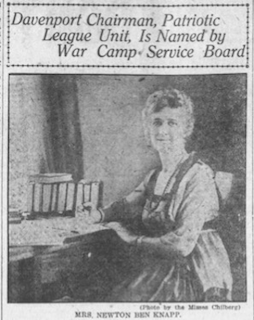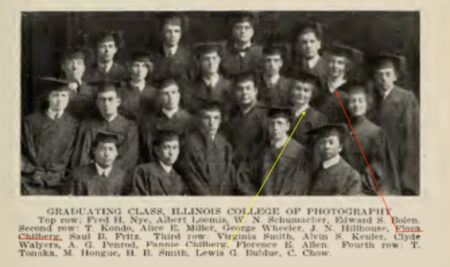100 years ago today, readers of the Dispatch newspaper in Moilne, Illinois, would have read this notice:

Earlier notices over the years in that same newspaper reveal just how very active the Missses Chilbeg — aka the sisters Fannie and Flora Chilberg— are with the Women’s Alliance of the First Unitarian church in Rock Island, Illinois. They host meetings for the group, as well as routinely setting up and manning a “photo studio” at the church’s fundraising bazaars.
Of course, the Misses Chilberg are just doing what they know best: photography is their profession. Working together professionally as “the Misses Chilberg” Fannie and Flora Chilberg offer “home photography”, traveling to client’s homes to take professional photos of families.
Now, we’ve run into other women here on Photographs, Pistols & Parasols doing “home” photography in the early 20th century, e.g. Gertrude Sayen and Margaret DeM. Brown, to name but a few. However, unlike Mrs. Sayen and Miss DeM. Brown, the Misses Chilberg don’ run a permanent studio location in addition – their sole business model seems to be taking pictures in other people’s homes.
This may be why it’s hard to find examples of their work. There a couple of photos in the newspapers that sport the “Misses Chilberg” photo credit, but those are few and far between, and my husband and I have yet to obtain a print of their work anywhere else. Interesting, of the 4 I’ve found in the newspaper, none are of children at home, which their ads proclaim to be their specialty.

Anyway, getting back Jan 1924, it’s worth mentioning that at this point the sisters have been in business for more than 10 years. They established themselves as photographers after graduating in 1913 from the Illinois College of Photography, in Effingham, Illinois, one of the premier photography training locations in the early 20th century. Here’s a photo of the March 1913 graduating class from that college. I’ve added arrows to point out Flora and Fannie. The photo is a little grainy, but you might be able to tell that the sisters are identical twins.

(photo published in Camera Craft publication)
Born in 1886, Fannie and Flora were already in their late 20s by the time they launched their photography careers in 1913. There are many notices in the newspaper about them traveling quite a bit for their work, as well as all the notices about their activities with the church group, including the one that appeared 100 years ago today.
Not only is their “home photography” business still thriving 11 years later in 1924, the business continues to flourish into 1927. In July of that year, there’s a notice in the newspaper that they are traveling to photograph the children of Arthur and Marcella Zimmerman in Waterloo, Iowa. The Zimmermans are family friends, so this is planned as both a business and pleasure trip for the sisters; they plan on an extended 10 day visit to the area.
An so, as the Chilberg sisters arrive in Waterloo on July 16, 1927, they immediately set off with a group of friends for a picnic, the group large enough to require several cars to transport them all to a local park. Fannie joins Arthur Zimmerman and his wife in Zimmerman’s car, while Flora gets a ride with a different friend, riding in the car following behind Zimmerman’s.
But before they get to the park, tragedy strikes.
A speeding car driven by a drunk driver comes barreling through an intersection and plows into the Zimmerman vehicle. The Zimmermans survive, but tragically Fannie Chilberg is killed.
There are lots of witnesses to the accident, including, sadly, Flora, who is in the car just behind Arthur Zimmerman’s car.

Now, by all accounts, Fannie and Flora were inseparable – as twin sisters, they were incredibly close. In fact, back in 1919, Flora was briefly married, but the marriage ended when her husband filed for divorce after only 35 days. In his divorce lawsuit, he stated that Flora told him she loved her sister, Fannie, more then she could ever loved him.
So, we can only imagine how devastated Flora must be after Fannie’s death.
However, Flora soldiers on in the business alone. Toward the end of 1927 she puts a notice in the paper to make it clear that that the “Misses Chilberg” photography business will continue, albeit with just her alone.

Indeed, over the next 15+ years Flora continues to run the business. Even when she relocates to Davenport, Iowa, her ads makes it clear that the Misses Chilberg home photography business is still going strong. Even with, over the years, she takes the occasional sabbatical for trips to Europe and elsewhere, she always comes back to running the business after her time away.
But then, suddenly, in 1944, at the age of 58, she announces she is retiring and closing the business.
What she doesn’t say in that notice, but what we learn from other notices in the newspapers in 1944, is that Flora is not only closing her business in Davenport, but she’s also moving to Waterloo, Iowa … to marry none other than her old friend (and recent widower) Arthur Zimmerman!

Flora and Arthur remain married for almost 30 years, until their deaths in 1972. However, there isn’t any indication in the available written records that Flora ever does photography again after her marriage in 1944.
As I said, it is true that there are the few surviving photos taken by Flora and Fannie Chilberg that we’ve been able to locate. However, the notice in the newspaper 100 years ago today let’s us glimpse another aspect to the lives the Misses Chilberg, two successful women photographers from the early 20th century.
